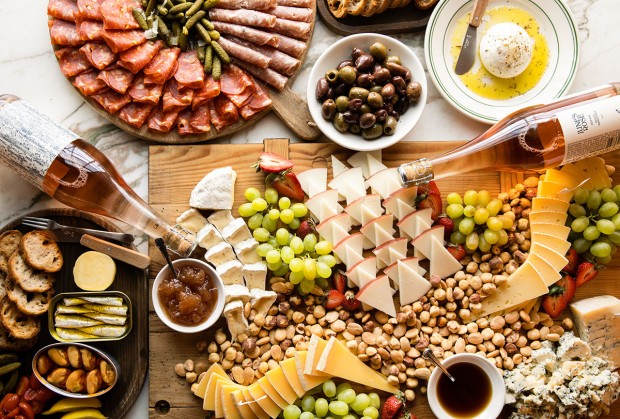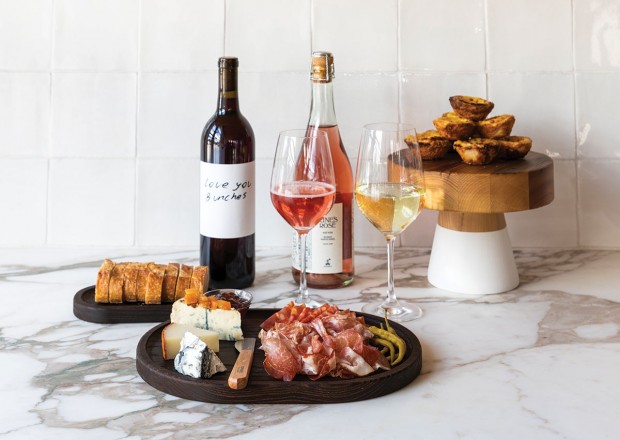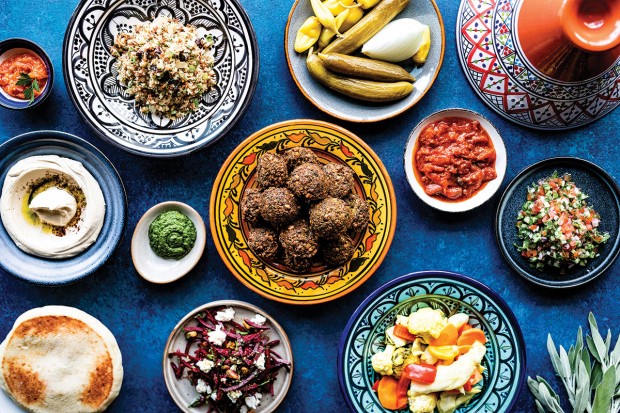Making the Cut: Charcuterie boards

November and December are months filled with holidays, kicked off by Día de Los Muertos. What a run it will be, from Diwali to Thanksgiving, then Hanukkah and Christmas, loaded with honey-baked ham, rib roasts, shortbread cookies, and bûche de noël. Something else we’ll be looking forward to – shared plates, small plates, and charcuterie boards.
According to the National Restaurant Association, charcuterie is a superstar. About 500 professional chefs surveyed in the 2023 What’s Hot Culinary Forecast said charcuterie is a small-plate favorite. While the art of arranging meats on a board has been around for hundreds of years, it has become a social media phenomenon in the last couple of years, and the trend shows no signs of waning. So, we’ve gathered tricks and tips from chefs and restaurants specializing in charcuterie because leading into the holidays, boards of all kinds land on tables as quickly as Justin Verlander’s fastball.
“During the holidays, people get into the spirit of sharing and giving, so naturally, when people host gatherings, we see an uptick in our bruschetta and cheese boards at the restaurant and through our catering services. Wine and cheese are synonymous with holidays,” says Danny Kirgan, Texas area director for the Phoenix-based Postino Wine Café.
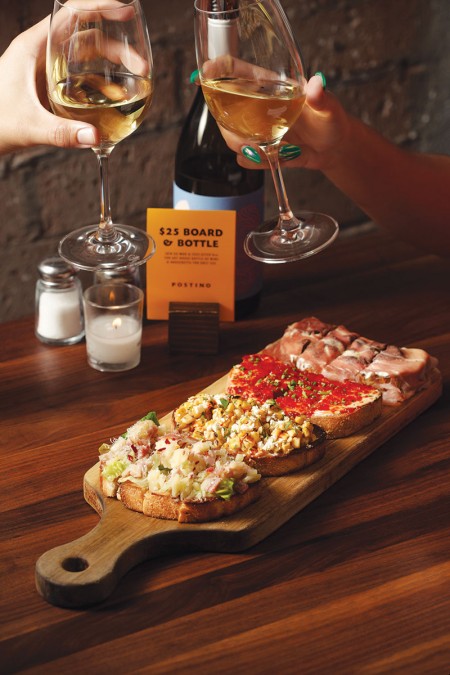
APPETIZING Regarding Postino’s popular bruschetta, selecting a board of four varieties from the dozen options is the toughest part. (Photo: Blake Bonillas)
Postino offers six different kinds of boards on reclaimed wood, including a gluten-free version. However, the signature board, available at six Houston-area locations, is the bruschetta board, with a choice of four out of 12 options per board. Each piece of bruschetta is cut into bite-size slices so everyone can have a sample. Along with the classic mozzarella, tomato, and basil combo, you’ll find such creative combinations as prosciutto with fresh fig and mascarpone, ricotta cheese with dates and pistachio, and smoked salmon with pesto.
A charcuterie board can be a statement piece and a time-saver because it typically requires little to no cooking. Once you gather all the nibbles, it takes minutes to assemble. Plus, you can make it and store it in the fridge until it’s ready to be served – and your guests can graze on it for hours. Talk about effortless entertaining. So, why not come up with several boards?
Brandi Key of Five 12 Restaurant Concepts did that for Daily Gather (800 Sorella Ct., No. 940) in CityCentre. The culinary director and executive chef created a board for daily pastries; another for smoked salmon; an elaborate $80 chef’s board with deviled eggs, Oysters Rockefeller, and beef tartare; and the Ultimate Brunch Board, which serves up to eight people. But she started with a simple, classic charcuterie board of artisanal meats and cheeses – curated by Houston Dairymaids owner Lindsey Schechter and including seasonal fruits, honey, sliced bread, and bar nuts (cashews and pecans) roasted with rosemary salt.
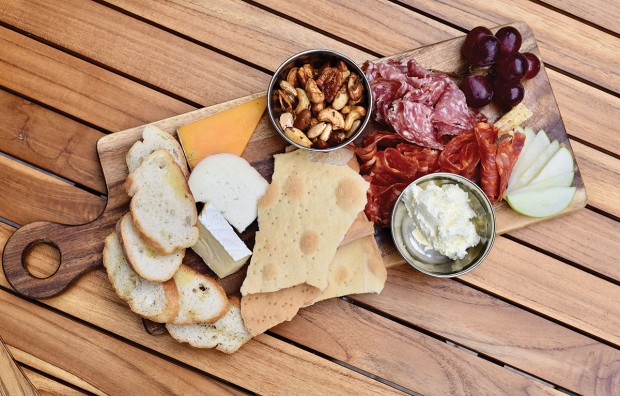
Daily Gather’s classic charcuterie board with meats and cheeses curated by Houston Dairymaids. (Photo: Kimberly Park)
You can assemble your own board quickly at home using Brandi's five key components: cheeses, cured meats, fruits, spreads, and bread or crackers. “A really good charcuterie board needs to have a whole lot of different textures,” the chef says. “The goal is to have different cheeses, different meats, and some nice crunchy things, fruit always, so as you’re eating through the board, many textures and experiences hit different places in your palate.”
When it comes to cheese, the more variety, the better. For this particular board, the rule of three applies, i.e., choose three different cheeses for the board. Offer a sharp cheese and a more mild option, or a soft cheese with a hard or semi-hard cheese for textural contrast. For example, Brandi says, “We’re using Red Rock Blue, a beautiful slight blue-vein cheddar from Wisconsin. It’s one of my favorites. We’re also using Baby Belletoile, a tiny brie that is soft and spreadable. Then we’re using PataCabra, a goat milk cheese from Spain. It’s nice and hard with lots of protein crystals, making it interesting.”
In terms of presentation, slice one block of cheese and fan the slices across the board while keeping another block whole. Mix it up visually to make it enjoyable. If you’re uncertain what cheeses to get, these days – along with Spec’s, Central Market, and Whole Foods – there’s Houston Dairymaids (2201 Airline Drive) and Montrose Cheese & Wine (1618 Westheimer Road), whose hands-on staff can help walk you through their curated selections of cheeses.
Next, pick two or three cured meats, such as a mild sausage, a smoked salami, and a third with a little more bite, such as Italy’s Levoni Salame Finocchio, a spiced salami with fennel seeds. Whether you opt for prosciutto, serrano, capocollo calabrese, soppressata, mortadella, French-style salami, or Spanish chorizo, get your meat thinly sliced. These are easy to arrange in folds, curls, or piles, making them pretty and easy for guests to grab one at a time.
Many experts prefer a combination of crackers and sliced baguettes on their boards. Again, the goal is to create textural variations. High-quality bread is a no-brainer, but getting a sturdy cracker that can withstand the weight of meat and cheese is also essential. Make the bread exciting and include a few varieties, such as a seeded one and another flavored with herbs.
The fourth element of a board is spreads, such as jams, preserves, and even honeycomb, which can add a slightly bitter or fruity sweetness to complement salty meats and cheeses. One of chef Philippe Schmit’s favorite spreads for a charcuterie board is truffle butter. “It’s so simple to make and such a nice addition to a board,” says the co-owner of PS-21.
At PS-21 (2712 Richmond Ave.), Philippe has taken the traditional French charcuterie tray one step further and introduced guests to the beloved tradition of l’apero, which is short for apéritif. An hour or so before dinner, guests unwind over cocktails and snacks, including charcuterie, tapenades, cod brandade, escargots, sardine rillettes, and other small bites.
Research always helps with finding new ideas, and there are plenty of places from which to sample and borrow ideas. We procured Philippe’s recipes for truffle butter and green olive tapenade, but we also wanted dips for the charcuterie board. The modern Israeli restaurant Hamsa (5555 Morningside Drive, No. 100) in Rice Village features the Wholeshebang, which features nine salatim, a catchall Hebrew term for spreads, dips, salads, pickles, and slaws. The salatim – which includes matbucha tomato-bell pepper compote, lemon tahini, labneh, tomato-feta salad, and carrot harissa – provided color and vivid flavors.
The final essential player on the board is the fruit. Some people keep it seasonal, such as peaches and figs. Most rely on grapes, which pair great with wine and cheese, and why not? Apples and pears are good, too. The role of fruit (olives and gherkin pickles, too) is to lend that acidic pop of flavor, which cuts through rich meats and cheeses. Fruit is a palate cleanser.
Once you have all the essential ingredients, add the extras to the board, such as dried fruits (dates, apricots, cranberries, etc.), pickles, crunchy veggies, and seeds or roasted nuts. Use these guys to fill in the blank spaces and add another dimension to your board.
Traditionally, charcuterie boards elicit visions of artisanal cured meats, but these days, creative boards are topped with everything from fresh fruit to chocolate. We won’t delve into the craze of the pounds of butter being spread, smeared, and swept across boards. But we are keen on dessert boards, and founder Sara Brook of Dessert Gallery Bakery & Café tried selling kits that included sweet treats and a template for her customers to make one at home. It contained miniature cupcakes, pecan pie bars, sand tart cookies, cake balls, truffles, tiny cookies, candied pretzels, sprinkles, and other goodies except fresh fruit.
“We mapped it out so you can see exactly how we did it. We gave them everything, including a picture. It was so cute, but people didn’t want to do it. They wanted us to do it,” Sara says.
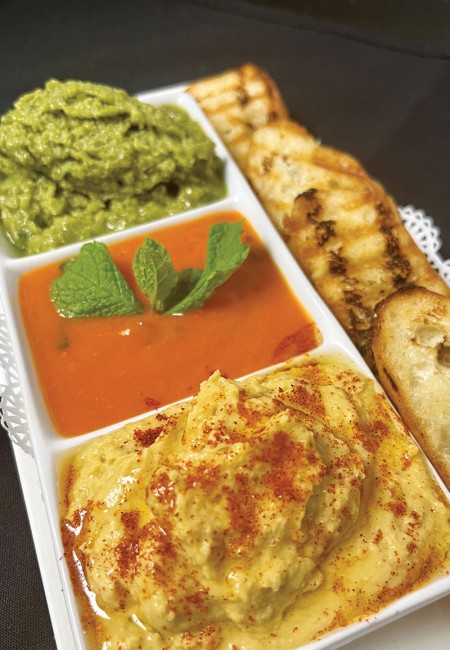
DIP, DIP PS-21’s trio of dips: Green tapenade, harissa pepper, confit garlic hummus, served with toasted bread.
1–1½ pounds brined green olives, such as Castelvetrano
8 basil leaves
8 garlic cloves
½ cup olive oil
¼ cup capers, rinsed
4 white anchovies, rinsed
White pepper to taste
½ cup corn oil
½ cup extra virgin oil
To pit olives, cover a cutting board with a kitchen towel. Spread olives in a single layer on the towel. Also, work in batches if necessary. Cover olives with a second towel, then use a heavy skillet to bash olives once or twice. Pits and flesh should separate easily. You should have about 1 cup of pitted olives. Transfer into a bowl and set aside.
This step is optional, but if you want a really vivid, green olive tapenade, blanch the basil in boiling water for one second, then immediately plunge the leaves into ice-cold water; set aside.
Place the garlic in a cup of cold water and bring to a boil, then immediately transfer the garlic into another small pot containing the olive oil. Bring the garlic to a simmer over medium-low heat. Reduce heat and simmer garlic for about 30 minutes.
Make the tapenade in a small food processor when the garlic is ready. Start with the dry ingredients and combine the garlic, olives, capers, and anchovies with one pulse. Next, add the basil and a pinch of white pepper. Finally, drizzle in the extra virgin oil and corn oil. Pulse one last time. If you prefer a smoother texture, pulse until you reach the consistency you like. To store, transfer to an airtight container. It will keep for a couple of weeks in the refrigerator. The tapenade may be served with toasted crusty bread and fresh, mild cheese or drizzled on sliced steak. Makes about 2 to 2½ cups.
Chef Phillippe Schmit’s Truffle Butter
Winter truffle season is from November through February. Central Market is a good source. When choosing, you’ll want the little fungi to be firm and avoid soft, spongy truffles.
½ cup (1 stick) salted French or Irish butter
½ ounce fresh winter truffle, finely chopped
Allow butter to sit at room temperature for about an hour. In a bowl, mash together butter and truffle.
Spoon the mixture onto a piece of parchment paper or plastic wrap, form into a log, and wrap well. Chill for at least a day or, even better, two days before using. Makes 8 servings.
1 ripe pear, chopped
1–2 tablespoons honey
1/4 teaspoon cinnamon
225–300 grams wheel of brie
Baguette slices, crostini, or crackers for serving
Preheat the oven to 350 degrees. In a bowl, combine pear, honey, and cinnamon.
Unwrap the brie and place the cheese in an oven-proof round casserole dish or small cast-iron skillet. Spoon the chopped pear mixture over the brie and cover with foil.
Place in the oven and bake for 12–15 minutes or until the brie is warmed through and melted. Serve with baguette slices, crostini, or crackers. Makes eight servings.
Note: There are so many ways to dress up brie. You can use apples or add toasted walnuts to the combo above. If you want more gooey goodness, cut off the brie's top rind, bake it, and add apricot preserves and roasted chopped walnuts. Makes 8 servings.
Editor’s note: Buzz dining columnist Dai Huynh is a James Beard food-journalism award winner and longtime Houston-based restaurant writer.
Want more buzz like this? Sign up for our Morning Buzz emails.
To leave a comment, please log in or create an account with The Buzz Magazines, Disqus, Facebook, or Twitter. Or you may post as a guest.


